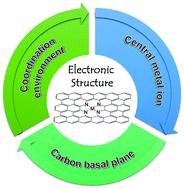当前位置:
X-MOL 学术
›
Mater. Horiz.
›
论文详情
Our official English website, www.x-mol.net, welcomes your
feedback! (Note: you will need to create a separate account there.)
Recent advances in tuning the electronic structures of atomically dispersed M–N–C materials for efficient gas-involving electrocatalysis
Materials Horizons ( IF 12.2 ) Pub Date : 2020-01-04 , DOI: 10.1039/c9mh01819k Dekang Huang 1, 2, 3, 4, 5 , Yanzhu Luo 1, 2, 3, 4 , Shu Li 1, 2, 3, 4 , Li Liao 1, 2, 3, 4 , Yunxiang Li 5, 6, 7, 8 , Hao Chen 1, 2, 3, 4 , Jinhua Ye 5, 6, 7, 8
Materials Horizons ( IF 12.2 ) Pub Date : 2020-01-04 , DOI: 10.1039/c9mh01819k Dekang Huang 1, 2, 3, 4, 5 , Yanzhu Luo 1, 2, 3, 4 , Shu Li 1, 2, 3, 4 , Li Liao 1, 2, 3, 4 , Yunxiang Li 5, 6, 7, 8 , Hao Chen 1, 2, 3, 4 , Jinhua Ye 5, 6, 7, 8
Affiliation

|
Owing to the intriguing physical, chemical, and electronic properties, atomically dispersed M–N–C materials are emerging as the most promising alternatives to noble metals for many gas-involving electrochemical reactions, like the oxygen evolution reaction, hydrogen evolution reaction, oxygen reduction reaction, and carbon dioxide reduction reaction. Current research on achieving high performance M–N–Cs is based on two aspects: one is to increase the density of active sites through a selection of appropriate precursors and smart design of the synthetic method, and the other is to boost the intrinsic activity of active sites through electronic structure modulation. In this review, we focus on the latter one and comprehensively summarize the reported strategies, including a judicious choice of central metal ions, modification of the carbon basal plane, and adjustment of the coordination environment of central metal ions, for achieving the optimized electronic structures of M–N–Cs and further correlate these structures with improved electrocatalytic performances, providing an in-depth understanding of M–N–Cs at the atomic level. Finally, to promote the practical application of M–N–Cs in clean and renewable energy conversion and storage technologies, some remaining challenges and future opportunities are pointed out.
中文翻译:

原子分散的M–N–C材料的电子结构调整的最新进展,以实现有效的涉及气体的电催化
由于令人着迷的物理,化学和电子性质,原子分散的M–N–C材料正在成为许多涉及气体的电化学反应(例如氧气分解反应,氢气分解反应,氧气还原)中最有希望的贵金属替代物反应和二氧化碳还原反应。当前有关实现高性能M–N–Cs的研究基于两个方面:一个是通过选择合适的前体和合成方法的智能设计来增加活性位点的密度,另一个是提高碳纳米管的固有活性。活动部位通过电子结构调制。在这篇评论中,我们重点关注后者,并全面总结了报告的策略,包括明智地选择中心金属离子,碳基面的修饰以及中心金属离子的配位环境的调整,以实现M–N–Cs的优化电子结构,并将这些结构与改善的电催化性能进一步关联,从而提供对M–N的深入了解–Cs在原子级别。最后,为了促进M–N–C在清洁和可再生能源转换和存储技术中的实际应用,指出了一些尚存的挑战和未来的机会。
更新日期:2020-01-04
中文翻译:

原子分散的M–N–C材料的电子结构调整的最新进展,以实现有效的涉及气体的电催化
由于令人着迷的物理,化学和电子性质,原子分散的M–N–C材料正在成为许多涉及气体的电化学反应(例如氧气分解反应,氢气分解反应,氧气还原)中最有希望的贵金属替代物反应和二氧化碳还原反应。当前有关实现高性能M–N–Cs的研究基于两个方面:一个是通过选择合适的前体和合成方法的智能设计来增加活性位点的密度,另一个是提高碳纳米管的固有活性。活动部位通过电子结构调制。在这篇评论中,我们重点关注后者,并全面总结了报告的策略,包括明智地选择中心金属离子,碳基面的修饰以及中心金属离子的配位环境的调整,以实现M–N–Cs的优化电子结构,并将这些结构与改善的电催化性能进一步关联,从而提供对M–N的深入了解–Cs在原子级别。最后,为了促进M–N–C在清洁和可再生能源转换和存储技术中的实际应用,指出了一些尚存的挑战和未来的机会。











































 京公网安备 11010802027423号
京公网安备 11010802027423号